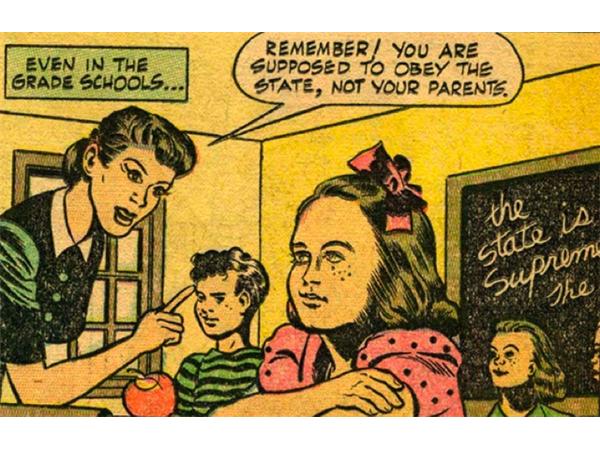
Illinois is poised to enact “Culturally Responsive Teaching and Leading Standards” and trash old standards which were focused on actual leaning.
“[GOP Rep. Steven] Reick pointed specifically to a portion of the new standards that call on teachers to ‘understand and value the notion that multiple lived experiences exist, that there is not one “correct” way of doing or understanding something, and that what is seen as ‘correct’ is most often based on our lived experiences.’
“He also pointed to another provision calling on teachers to ‘(a)ssess how their biases and perceptions affect their teaching practice and how they access tools to mitigate their own behavior (racism, sexism, homophobia, unearned privilege, Eurocentrism, etc.)’
“Another provision calls on educators to ‘(b)e aware of the effects of power and privilege and the need for social advocacy and social action to better empower diverse students and communities.’”
Unless at least some Democrats oppose this new set of standards, it will automatically be enacted and take effect in four years.
The full proposals can be read here or at the end of this post, but here are some highlights of the new standards, which start on page 176 of the document and page 14576 of the register:
- Self-Awareness and Relationships to Others – Culturally responsive teachers and leaders are reflective and gain a deeper understanding of themselves and how they impact others, leading to more cohesive and productive student development as it relates to academic and social-emotional development for all students.
- Systems of Oppression – Culturally responsive teachers and leaders understand that there are systems in our society that create and reinforce inequities, thereby creating oppressive conditions. Educators work actively against these systems in their everyday roles in educational institutions.
- Students as Individuals – Culturally responsive teachers and leaders view and value their students as individuals within the context of their families and communities.
- Students as Co-Creators – Culturally responsive teachers and leaders (whofundamentally believe all students are capable) center learning around students’ experiences and position them as co-creators, with emphasis on prioritizing historically marginalized students.
- Leveraging Student Activism – Culturally responsive teachers and leaders will support and create opportunities for student advocacy and representation in the content and classroom.
- Content Selections in All Curricula – Culturally responsive teachers and leaders intentionally embrace student identities and prioritize representation in the curriculum. In turn, students are not only given a chance to identify with the curriculum, they become exposed to other cultures within their schools and both their local and global communities.
- Student Representation in the Learning Environment – Culturally responsive teachers and leaders ensure the diversity of their student population is equally represented within the learning environment. In turn, all members of the student population feel seen, heard, and affirmed. Exceptionally well-versed culturally responsive teachers and leaders provide exposure to underrepresented or misrepresented minority groups, even when they are not present within the population of their school and community at large.
The evil unwoke provisions that are being repealed:
- Content Knowledge – The competent teacher understands the central concepts, methods of inquiry, and structures of disciplines and creates learning experiences that make the content meaningful to all students.
- Human Development and Learning – The competent teacher understands how individuals grow, develop, and learn and provides learning opportunities that support the intellectual, social, and personal development of all students.
- Diversity – The competent teacher understands how students differ in their approaches to learning and creates instructional opportunities that are adapted to diverse learners.
- Planning for Instruction – The competent teacher understands instructional planning and designs instruction based upon knowledge of the discipline, students, the community, and curriculum goals.
- Learning Environment – The competent teacher uses an understanding of individual and group motivation and behavior to create a learning environment that encourages positive social interaction, active engagement in learning, and self-motivation.
- Instructional Delivery – The competent teacher understands and uses a variety of instructional strategies to encourage students’ development of critical thinking, problem-solving, and performance skills.
- Communication – The competent teacher uses knowledge of effective written, verbal, non-verbal, and visual communication techniques to foster active inquiry, collaboration, and supportive interaction in the classroom.
- Assessment – The competent teacher understands various formal and informal assessment strategies and uses them to support the continuous development of all students.
- Collaborative Relationships – The competent teacher understands the role of the community in education and develops and maintains collaborative relationships with colleagues, parents/guardians, and the community to support students’ learning and well-being.
- Reflection and Professional Growth – The competent teacher is a reflective practitioner who continually evaluates how choices and actions affect students, parents, and other professionals in the learning community and actively seeks opportunities to grow professionally.
- Professional Conduct and Leadership – The competent teacher understands education as a profession, maintains standards of professional conduct, and provides leadership to improve students’ learning and well-being.







Pingback: In The Mailbox: 02.08.21 : The Other McCain